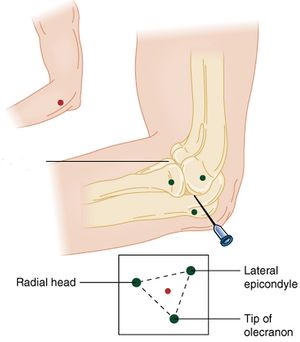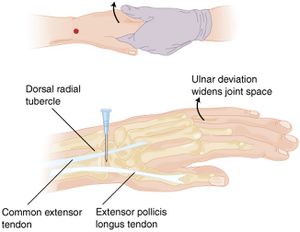We need you! Join our contributor community and become a WikEM editor through our open and transparent promotion process.
Arthrocentesis
From WikEM
Contents
Indications
- Suspicion of septic arthritis
- Suspicion of crystal induced arthritis
- Evaluation of therapeutic response for septic arthritis
- Unexplained arthritis with synovial effusion
- Evaluation of joint capsule integrity if overlying laceration
Relative Indications
- Therapeutic (decrease intra-articular pressure, injection of anesthetics/steroids)
Contraindications
- No absolute contraindications for diagnostic arthrocentesis
- Do not inject steroids into a joint that you suspect is already infected
- Relative Contraindications:
- Overlying cellulitis
- Coagulopathy
- Joint prosthesis (refer to ortho)
Equipment Needed
- Betadine or Chlorhexadine
- Sterile gloves/drape
- Sterile gauze
- Lidocaine
- Syringes
- Small syringe (6-12cc) for injection of local anesthetic
- Large syringe (one 60cc or two 30cc) for aspiration
- Needles
- 18 gauge: knee
- 20 gauge: most other joints
- 25 gauge: MTP joints
- 27 gauge for anesthetic injection
- Collection tubes (red top and purple for crystal analysis)
- Culture bottles
- Consider utilizing U/S to assess for effusion
Procedure
- Prep area with betadine or chlorhexadine using circular motion moving away from joint x 3
- Drape joint in sterile fashion
- Inject lidocaine with 25-30ga needle superficially and then into deeper tissues
- Insert 18ga needle (for larger joints) into joint space while pulling back on syringe
- Stop once you aspirate fluid; aspirate as much fluid as possible
- Send: cell count, culture, Gram Stain, crystal analysis
Approach
Shoulder
- Anterior approach
- Sit patient upright facing you
- Insert needle just lateral to coracoid process (between coracoid process and humeral head)
- Direct needle posteriorly
- Posterior Approach
- Sit patient upright with back facing you
- Palpate scapular spine to its lateral limit (the acromion)
- Identify the posterolateral corner of the acromion
- Insert 1.5-in needle 1 cm inferior and 1 cm medial to this corner
- Direct needle anterior and medial toward presumed position of coracoid process
- Glenohumeral joint is located at a depth of approximately 1-1.5in
Elbow
- Place elbow in 90o flexion, resting on a table, with hand prone
- Locate radial head, lateral epicondyle, and lateral aspect of olecranon tip
- These landmarks form the anconeus triangle
- Palpate a sulcus just proximal to the radial head (in the middle of the triangle)
- Insert needle into sulcus directed medial and perpendicular to radius toward distal end of antecubital fossa
Wrist
- Palpate landmarks with wrist in neutral position:
- Radial tubercle of distal radius
- Anatomic snuffbox
- Extensor pollicis longus tendon
- Common extensor tendon of index finger
- Insert needle perpendicular to skin, ulnar to radial tubercle and anatomic snuffbox, between extensor pollicis longus and common extensor tendons
Knee
- Can be entered medially or laterally to the patella, superior or inferior to patella
- Fully extend knee and ensure quadriceps muscle is relaxed (optionally bump with 20 deg of flexion)
- Place your thumb on the patella and slide it over as you enter with needle
- For Suprapatellar Approach 1 cm lateral and 1 cm superior
- Identify midpoint of patella; insert needle either 1 cm lateral or medial
- Direct needle posterior to patella and horizontally toward the joint space
- Compression or "milking" applied to both sides of joint space may facilitate aspiration
Ankle
- Lateral approach (subtalar)
- Keep foot perpendicular to leg
- Enter subtalar joint just below tip of lateral malleolus
- Direct needle medially toward joint space
- Medial approach (tibiotalar)
- Have patient supine with foot perpendicular to leg
- Palpate sulcus lateral to medial malleolus and medial to TA and EHL tendons
- Then plantarflex foot with needle entering skin overlying the sulcus
- Angle needle slightly cephalad as it passes between medial malleolus and TA tendon
Hip[1]
- Should only be done under ultrasound guidance
- Orient your probe along the axis of the femoral neck (indicator towards abdomen)
- Identify Landmarks (Femoral V/A/N, Acetabular Labrum, Femoral Head/Neck)
- Effusion will be seen between femoral head/neck and the iliopsoas muscle
- Insert needle under probe, making sure that you know where patient's femoral V/A/N are
Metacarpophalangeal
- Have palm facing down and apply gentle traction to the affected digit
- Insert needle dorsally just medial or lateral to midline and proximal to the base of the proximal phalanx
Interphalangeal
- Have palm facing down and apply gentle traction to the affected digit
- Insert needle dorsally medial or lateral to midline and proximal to base of middle or distal phalanx
Metatarsophalangeal
- Patient supine with flexion of the MTP joint 15-20 degrees and apply gentle traction
- Insert needle dorsally just medial or lateral to midline between the metatarsal head and base of proximal phalanx
Interphalangeal
- Patient supine with joint flexed 15-20 degrees with gentle traction
- Insert needle dorsally, medial or lateral to midline between head of proximal phalanx and base of more distal phalanx
Complications
- Pain
- Infection
- Re-accumulation of effusion
- Damage to tendons, nerves, or blood vessels
Evaluation
Arthrocentesis of synoval fluid
| Synovium | Normal | Noninflammatory | Inflammatory | Septic |
| Clarity | Transparent | Transparent | Cloudy | Cloudy |
| Color | Clear | Yellow | Yellow | Yellow |
| WBC | <200 | <200-2000 | 200-50,000 |
>1,100 (prosthetic joint) >25,000; LR=2.9 >50,000; LR=7.7 >100,000; LR=28 |
| PMN | <25% | <25% | >50% |
>64% (prosthetic joint) >90% |
| Culture | Neg | Neg | Neg | >50% positive |
| Lactate | <5.6 mmol/L | <5.6 mmol/L | <5.6 mmol/L | >5.6 mmol/L |
| LDH | <250 | <250 | <250 | >250 |
| Crystals | None | None | Multiple or none | None |
See Also
External Links
- http://www.youtube.com/watch?v=fZ2dcZhoGP8 Arthrocentesis
- http://emprocedures.com/arthrocentesis/introduction.htm
References
- ↑ *Freeman, K., A. Dewitz, et al. (2007). "Ultrasound-guided hip arthrocentesis in the ED." Am J Emerg Med 25(1): 80-86.
Video


